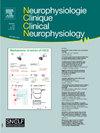The pleasantness of foods
IF 2.4
4区 医学
Q2 CLINICAL NEUROLOGY
Neurophysiologie Clinique/Clinical Neurophysiology
Pub Date : 2025-01-01
DOI:10.1016/j.neucli.2024.103031
引用次数: 0
Abstract
Food pleasantness is largely based on the palatability of food and is linked to taste. Along with homeostatic and cognitive control, it forms part of the control of food intake (hedonic control), and does not only correspond to the pleasure that can be described of food intake. There are many factors that cause variations in eating pleasantness between individuals, such as age, sex, culture, co-morbidities, treatments, environmental factors or the specific characteristics of foods. The control of food intake is based on four determinants: conditioned satiety, the reward system, sensory specific satiety and alliesthesia. These four determinants follow one another over time, in the per-prandial and inter-prandial periods, and complement one another. There are many cerebral areas involved in the hedonic control of food intake. The most involved brain areas are the orbitofrontal and anterior cingulate cortices, which interact with deep neural structures (amygdala, striatum, substantia nigra) for the reward circuit, with the hippocampi for memorising pleasant foods, and even with the hypothalamus and insula, brain areas more recently involved in the physiology of food pleasantness. Changes in brain activity secondary to modulation of food pleasantness can be measured objectively by recording taste-evoked potentials, an electroencephalography technique with very good temporal resolution.
食物的愉悦。
食物的愉悦性很大程度上是基于食物的适口性,并与味道有关。与体内平衡和认知控制一起,它构成了对食物摄入的控制(享乐控制)的一部分,并且不仅与可以描述食物摄入的快乐相对应。有许多因素导致个体之间饮食愉悦度的差异,如年龄、性别、文化、合并症、治疗、环境因素或食物的特定特征。对食物摄入的控制基于四个决定因素:条件饱腹感、奖励系统、感觉特异性饱腹感和联觉。这四个决定因素随着时间的推移,在餐前和餐间,彼此遵循,并相互补充。大脑中有许多区域与食物摄入的享乐控制有关。参与最多的大脑区域是眶额皮质和前扣带皮质,它们与深层神经结构(杏仁核、纹状体、黑质)相互作用,形成奖励回路,与记忆愉悦食物的海马体相互作用,甚至与下丘脑和脑岛相互作用,这些大脑区域最近与食物愉悦的生理学有关。通过记录味觉诱发电位(一种具有很好的时间分辨率的脑电图技术),可以客观地测量食物愉悦调节后大脑活动的变化。
本文章由计算机程序翻译,如有差异,请以英文原文为准。
求助全文
约1分钟内获得全文
求助全文
来源期刊
CiteScore
5.20
自引率
3.30%
发文量
55
审稿时长
60 days
期刊介绍:
Neurophysiologie Clinique / Clinical Neurophysiology (NCCN) is the official organ of the French Society of Clinical Neurophysiology (SNCLF). This journal is published 6 times a year, and is aimed at an international readership, with articles written in English. These can take the form of original research papers, comprehensive review articles, viewpoints, short communications, technical notes, editorials or letters to the Editor. The theme is the neurophysiological investigation of central or peripheral nervous system or muscle in healthy humans or patients. The journal focuses on key areas of clinical neurophysiology: electro- or magneto-encephalography, evoked potentials of all modalities, electroneuromyography, sleep, pain, posture, balance, motor control, autonomic nervous system, cognition, invasive and non-invasive neuromodulation, signal processing, bio-engineering, functional imaging.

 求助内容:
求助内容: 应助结果提醒方式:
应助结果提醒方式:


